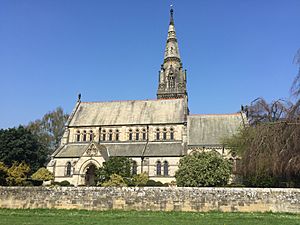Church of Christ the Consoler facts for kids
Quick facts for kids Christ the Consoler |
|
|---|---|
| Church of Christ the Consoler | |

Christ the Consoler, Skelton on Ure
|
|
| 54°06′29″N 1°26′56″W / 54.108°N 1.449°W | |
| OS grid reference | SE 3599 6795 |
| Location | Skelton-cum-Newby, North Yorkshire |
| Country | England |
| Denomination | Anglican |
| History | |
| Status | In the care of the Churches Conservation Trust |
| Founded | June 1870 |
| Architecture | |
| Heritage designation | Listed building – Grade I |
| Architect(s) | William Burges |
| Architectural type | Gothic Revival |
| Style | Early English |
| Administration | |
| Parish | Newby with Mulwith |
The Church of Christ the Consoler is a beautiful old church. It was built a long time ago, during the Victorian era. This church is special because it was designed in a style called Gothic Revival by a famous architect named William Burges. You can find it in the peaceful grounds of Newby Hall, in Skelton-on-Ure, North Yorkshire, England. The church was built to remember Frederick Vyner, who was the brother-in-law of a very important person, George Robinson, 1st Marquess of Ripon. Today, this church is a very important historical building, known as a Grade I listed building. It is looked after by the Churches Conservation Trust, making sure it stays safe for everyone to see.
Contents
The Story Behind the Church's Creation
Frederick Vyner had a sad story. In 1870, he was captured by a group of people in Greece. Even though a large amount of money was being collected to free him, he was sadly killed. His mother, Lady Mary Vyner, decided to use the money that was collected to build a special church in his memory. This church would be on her land in Yorkshire. Frederick's sister, Lady Ripon, also decided to build a similar church on her own land. Her church is called St Mary's Church and is located at Studley Royal.
Who Designed the Church?
The famous architect William Burges was chosen to design both churches in 1870. He was a very talented designer. He might have been chosen because Frederick Vyner was friends with one of Burges's biggest supporters, John Crichton-Stuart, 3rd Marquess of Bute, when they were at Oxford University. The building of the Church of Christ the Consoler started in 1871. It was finished and ready by 1876.
Exploring the Church's Design
The outside of the church is made from strong, grey stone called Catraig stone. The decorative parts are made from Morcar stone. The style is called Early English, which is a type of Gothic architecture.
Inside the Church: A World of Art
When you step inside, you'll see that the walls are covered with beautiful white limestone. The interior is very rich and detailed. Many talented artists worked on it, including Thomas Nicholls and Lonsdale, who were often part of William Burges's team. This church is special because it shows a change in Burges's style. He usually preferred a French Gothic style, but for this church, he was inspired by English designs.
What Experts Say About the Church
A famous architectural historian named Nikolaus Pevsner described the church as "very original." He said it feels "very grand," even if it's a bit "heavy." In 2007, another architectural historian, James Stevens Curl, said this church was one of five important buildings where you can still see the amazing skill of Victorian designers. He mentioned its wonderful use of color, detailed work, and grand style.
See also
- Grade I listed buildings in North Yorkshire (district)
- Listed buildings in Newby with Mulwith
- List of churches preserved by the Churches Conservation Trust in Northern England
- Spectre of Newby Church

